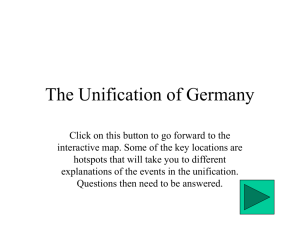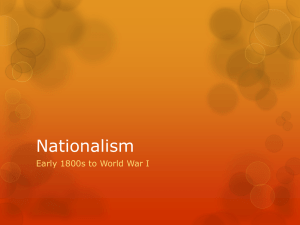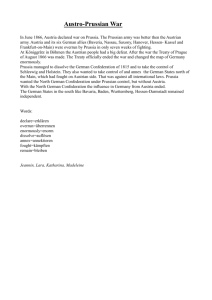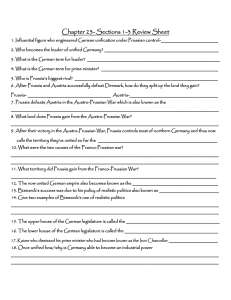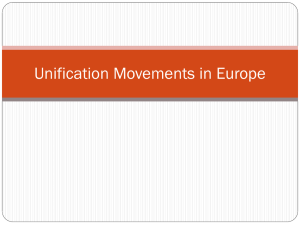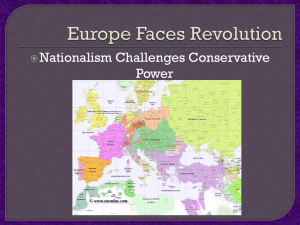Modern European History Name: ___________________ Date: ____________
advertisement
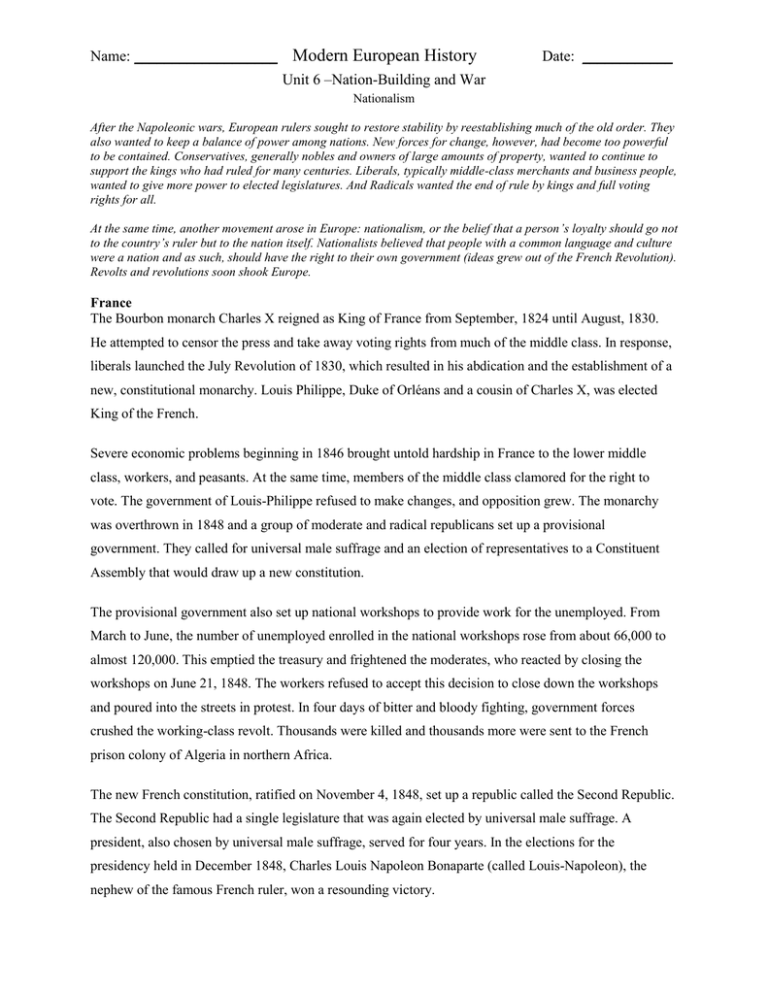
Name: ___________________ Modern European History Date: ____________ Unit 6 –Nation-Building and War Nationalism After the Napoleonic wars, European rulers sought to restore stability by reestablishing much of the old order. They also wanted to keep a balance of power among nations. New forces for change, however, had become too powerful to be contained. Conservatives, generally nobles and owners of large amounts of property, wanted to continue to support the kings who had ruled for many centuries. Liberals, typically middle-class merchants and business people, wanted to give more power to elected legislatures. And Radicals wanted the end of rule by kings and full voting rights for all. At the same time, another movement arose in Europe: nationalism, or the belief that a person’s loyalty should go not to the country’s ruler but to the nation itself. Nationalists believed that people with a common language and culture were a nation and as such, should have the right to their own government (ideas grew out of the French Revolution). Revolts and revolutions soon shook Europe. France The Bourbon monarch Charles X reigned as King of France from September, 1824 until August, 1830. He attempted to censor the press and take away voting rights from much of the middle class. In response, liberals launched the July Revolution of 1830, which resulted in his abdication and the establishment of a new, constitutional monarchy. Louis Philippe, Duke of Orléans and a cousin of Charles X, was elected King of the French. Severe economic problems beginning in 1846 brought untold hardship in France to the lower middle class, workers, and peasants. At the same time, members of the middle class clamored for the right to vote. The government of Louis-Philippe refused to make changes, and opposition grew. The monarchy was overthrown in 1848 and a group of moderate and radical republicans set up a provisional government. They called for universal male suffrage and an election of representatives to a Constituent Assembly that would draw up a new constitution. The provisional government also set up national workshops to provide work for the unemployed. From March to June, the number of unemployed enrolled in the national workshops rose from about 66,000 to almost 120,000. This emptied the treasury and frightened the moderates, who reacted by closing the workshops on June 21, 1848. The workers refused to accept this decision to close down the workshops and poured into the streets in protest. In four days of bitter and bloody fighting, government forces crushed the working-class revolt. Thousands were killed and thousands more were sent to the French prison colony of Algeria in northern Africa. The new French constitution, ratified on November 4, 1848, set up a republic called the Second Republic. The Second Republic had a single legislature that was again elected by universal male suffrage. A president, also chosen by universal male suffrage, served for four years. In the elections for the presidency held in December 1848, Charles Louis Napoleon Bonaparte (called Louis-Napoleon), the nephew of the famous French ruler, won a resounding victory. Events after the revolution of 1848 moved toward the restoration of the monarchy. Four years after his election as president in 1848, Louis-Napoleon returned to the people to ask for the restoration of the empire. In this plebiscite, or popular vote, 97 percent responded with a yes vote. On December 2, 1852, Louis-Napoleon assumed the title of Emperor Napoleon III (Napoleon II was the son of Napoleon Bonaparte, but he never ruled France). The Second Empire had begun. The government of Napoleon III was clearly authoritarian. As chief of state, Napoleon III controlled the armed forces, police, and civil service. Only he could introduce legislation and declare war. The Legislative Corps gave an appearance of representative government, because the members of the group were elected by universal male suffrage for six-year terms. However, they could neither initiate legislation nor affect the budget. Napoleon III completely controlled the government and limited civil liberties. To distract the public from their loss of political freedom, he focused on expanding the economy. Government subsidies helped foster the rapid construction of railroads, harbors, roads, and canals. In the midst of this economic expansion, Napoleon III also carried out a vast rebuilding of the city of Paris. The old Paris of narrow streets and walls was replaced by a modern Paris of broad boulevards, spacious buildings, public squares, an underground sewage system, a new public water supply system, and gaslights. In the 1860s, opposition to some of Napoleon’s economic and governmental policies arose. In response, Napoleon III began to liberalize his regime. For example, he gave the legislature more power. After the French were defeated in the Franco-Prussian War in 1870, however, the Second Empire fell. Germany News of the 1848 revolution in France led to upheaval in other parts of Europe. The Congress of Vienna, which lasted from 1814 to 1815, had recognized the existence of 38 independent German states (called the German Confederation). Of these, Austria and Prussia were the two great powers. The other states varied in size. In 1848 cries for change led many German rulers to promise constitutions, a free press, jury trials, and other liberal reforms. In May 1848, an all-German parliament, called the Frankfurt Assembly, was held to fulfill a liberal and nationalist dream - the preparation of a constitution for a new united Germany. The Frankfurt Assembly’s proposed constitution provided for a German state with a parliamentary 2 government and a hereditary emperor ruling under a limited monarchy. The constitution also allowed for direct election of deputies to the parliament by universal male suffrage. Ultimately, however, the Frankfurt Assembly failed to gain the support needed to achieve its goal. Frederick William IV of Prussia, to whom the throne was offered, refused to accept the crown from a popularly elected assembly. Thus, the assembly members had no real means of forcing the German rulers to accept their drafted constitution. German unification was not achieved. After the Frankfurt Assembly failed to achieve German unification in 1848 and 1849, Germans looked to Prussia for leadership in the cause of German unification. In the course of the nineteenth century, Prussia had become a strong, prosperous, and authoritarian state. The Prussian king had firm control over the government and the army. Prussia was also known for its militarism, or reliance on military strength. In the 1860s, Prussian King William I tried to enlarge his army. When the Prussian legislature refused to levy new taxes for the proposed changes, William I appointed a new prime minister, Count Otto von Bismarck, to preside over the legislature. Bismarck has often been seen as the foremost nineteenth-century practitioner of realpolitik - the “politics of reality,” a politics based on practical matters rather than on ethics. Bismarck openly voiced his strong dislike for anyone who opposed him. After his appointment, Bismarck ignored the legislative opposition to the military reforms. He proceeded to collect taxes and strengthen the army. From 1862 to 1866, Bismarck governed Prussia without approval of the parliament. In the meantime, he followed an active foreign policy, which soon led to war. After defeating Denmark with Austrian help in 1864, Prussia gained control of the duchies of Schleswig and Holstein. Bismarck then goaded the Austrians into a war on June 14, 1866. The Austrians, no match for the well-disciplined Prussian army, were defeated on July 3. Prussia now organized the German states north of the Main River into the North German Confederation. The southern German states, which were largely Catholic, feared Protestant Prussia. However, they also feared France, their western neighbor. As a result, they agreed to sign military alliances with Prussia for protection against France. Prussia now dominated all of northern Germany, and the growing power and military might of Prussia worried France. In 1870 Prussia and France became embroiled in a dispute over the candidacy of a 3 relative of the Prussian king for the throne of Spain. Taking advantage of the situation, Bismarck pushed the French into declaring war on Prussia on July 19, 1870 - a conflict called the Franco-Prussian War. Prussian armies advanced into France. At Sedan, on September 2, 1870, an entire French army and the French ruler, Napoleon III, were captured. Paris finally surrendered on January 28, 1871. An official peace treaty was signed in May. France had to pay 5 billion francs (about $1 billion) and give up the provinces of Alsace and Lorraine to the new German state. The loss of these territories left the French burning for revenge. Even before the war had ended, the southern German states had agreed to enter the North German Confederation. On January 18, 1871, Bismarck and 600 German princes, nobles, and generals filled the Hall of Mirrors in the palace of Versailles, 12 miles (19.3 km) outside Paris. William I of Prussia was proclaimed kaiser, or emperor, of the Second German Empire, or Reich (the first was the medieval Holy Roman Empire). The Prussian monarchy and the Prussian army had achieved German unity. The authoritarian and militaristic values of Prussia were triumphant in the new German state. With its industrial resources and military might, Germany had become the strongest power in Europe. 1. What were the four states annexed by Prussia, in 1866? _________________________ _________________________ _________________________ _________________________ 2. What three states joined Prussia to form the Northern German Confederation, 1867? _________________________ _________________________ ________________________ 3. What three states joined the German Empire, 1871? _________________________ _________________________ _________________________ 4 Italy The Congress of Vienna had set up nine states in Italy, which were divided among the European powers. These states included the Kingdom of Piedmont in the north; the Two Sicilies (Naples and Sicily); the Papal States; a handful of small states; and the northern provinces of Lombardy and Venetia, which were now part of the Austrian Empire. In 1848 a revolt broke out against the Austrians in Lombardy and Venetia. Revolutionaries in other Italian states also took up arms and sought to create liberal constitutions and a unified Italy. By 1849, however, the Austrians had reestablished complete control over Lombardy and Venetia. The old order also prevailed in the rest of Italy. In 1850 Austria was still the dominant power on the Italian Peninsula. After the failure of the revolution of 1848, people began to look to the northern Italian state of Piedmont for leadership in achieving the unification of Italy. The royal house of Savoy ruled the Kingdom of Piedmont. Included in the kingdom were Piedmont, the island of Sardinia, Nice, and Savoy. The ruler of the kingdom, beginning in 1849, was King Victor Emmanuel II. The king named Camillo di Cavour his prime minister in 1852. As prime minister, Cavour pursued a policy of economic growth in order to equip a large army. Cavour, however, knew that Piedmont’s army was not strong enough to defeat the Austrians. So he made an alliance with the French emperor LouisNapoleon. Cavour then provoked the Austrians into declaring war in 1859. Following that conflict, a peace settlement gave Nice and Savoy to the French. Lombardy, which had been under Austrian control, was given to Piedmont. Austria retained control of Venetia. Cavour’s success caused nationalists in other Italian states (Parma, Modena, and Tuscany) to overthrow their governments and join their states to Piedmont. Meanwhile, in southern Italy, a new Italian leader had arisen. Giuseppe Garibaldi, a dedicated patriot, raised an army of a thousand volunteers. A branch of the Bourbon dynasty ruled the Two Sicilies (Sicily and Naples), and a revolt had broken out in Sicily against the king. Garibaldi’s forces landed in Sicily and, by the end of July 1860, controlled most of the island. In August, Garibaldi’s forces crossed over to the mainland and began a victorious march up the Italian Peninsula. The entire Kingdom of the Two Sicilies fell in early September. Garibaldi chose to turn over his conquests to Piedmont. On March 17, 1861, a new state of Italy was proclaimed under King Victor Emmanuel II. The task of unification was not yet complete, however. 5 Austria still held Venetia in the north; and Rome was under the control of the pope, supported by French troops. The Italians gained control of Venetia as a result of supporting Prussia in a war between Austria and Prussia. In 1870, during the Franco-Prussian War, French troops withdrew from Rome. Their withdrawal enabled the Italian army to annex Rome on September 20, 1870. Rome became the capital of the new European state. 1. What territories (all caps) were annexed by Sardinia in 1860? __________________________ __________________________ __________________________ __________________________ __________________________ 2. What Austrian territory was annexed by Sardinia in 1866? __________________________ 3. Which country annexed Rome in 1870? __________________________ 6
